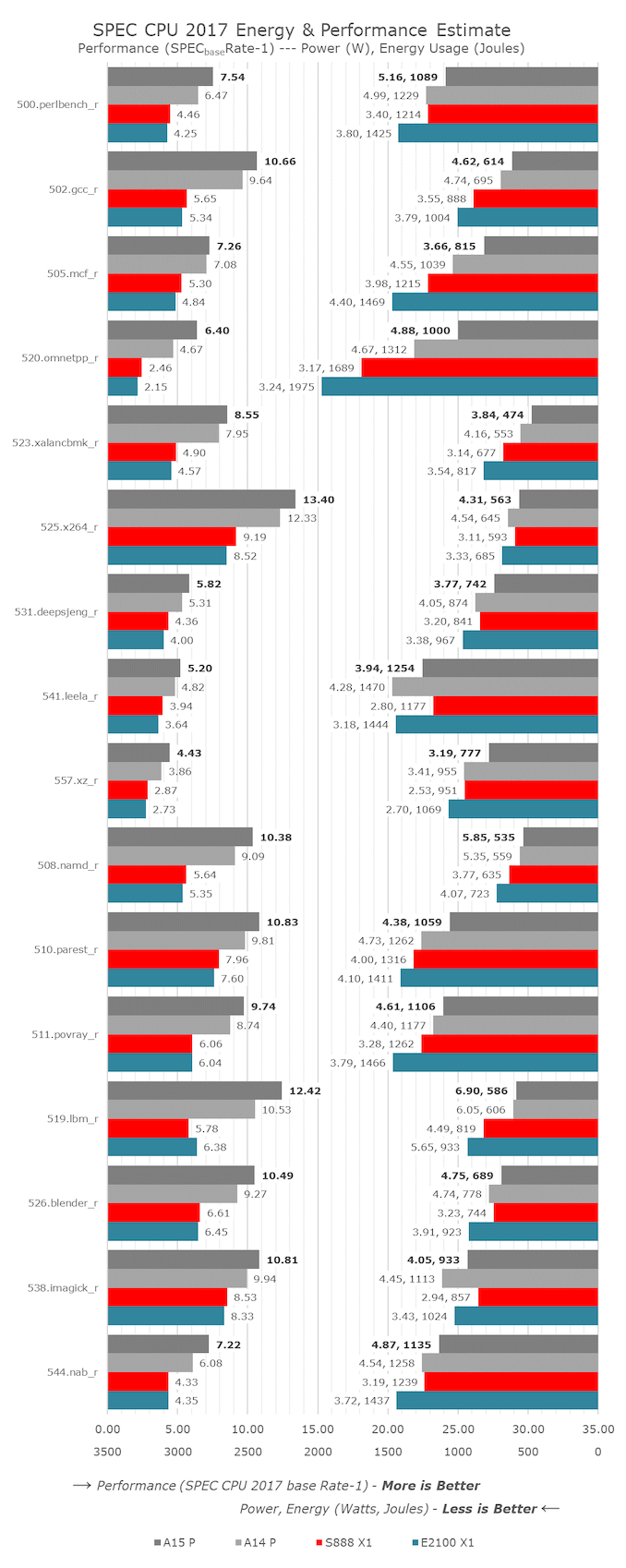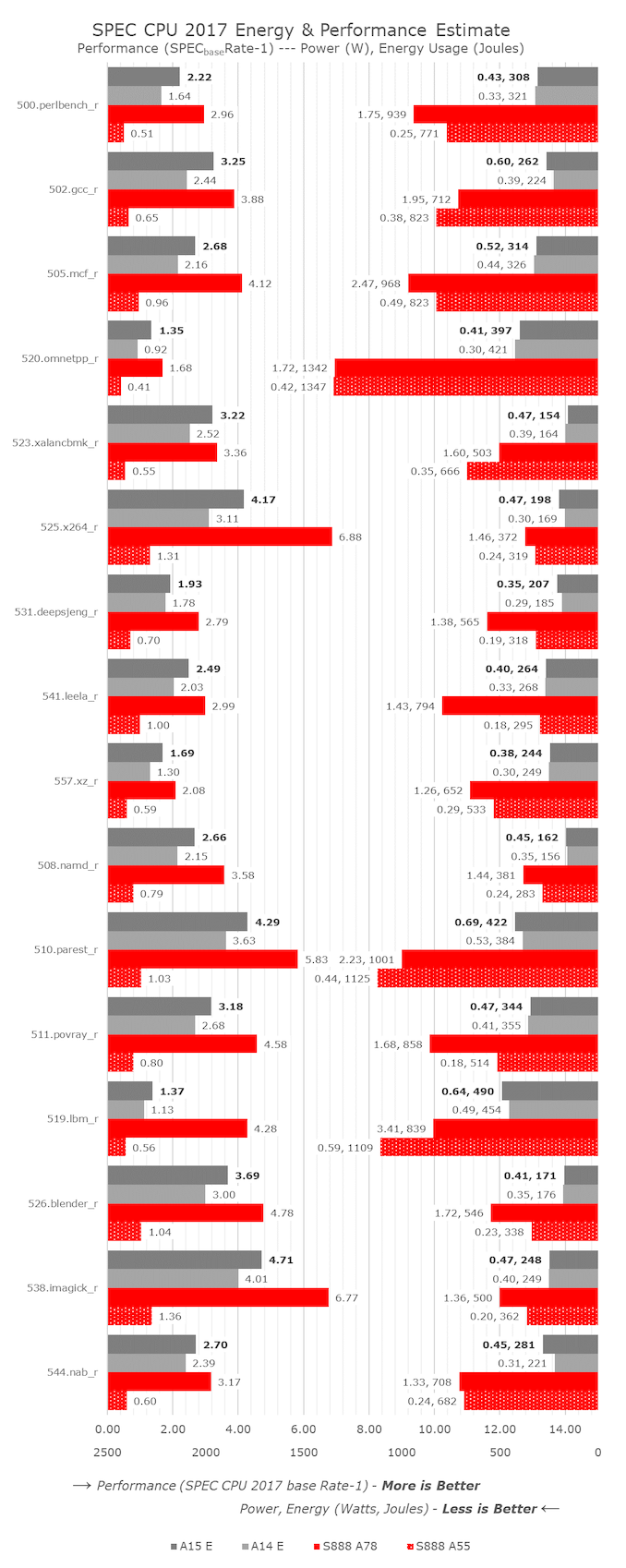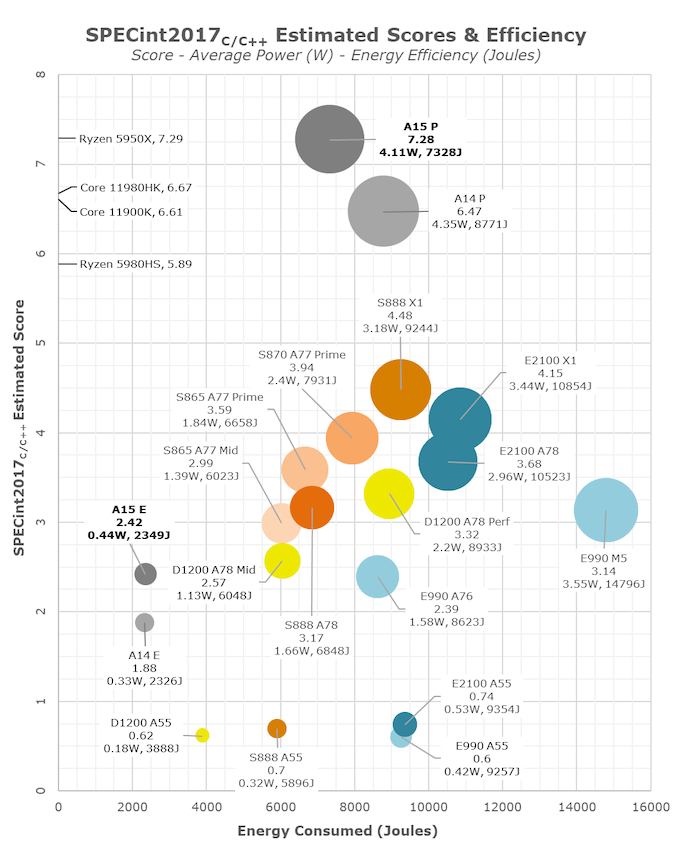The Apple A15 SoC Performance Review: Faster & More Efficient
by Andrei Frumusanu on October 4, 2021 9:30 AM EST- Posted in
- Mobile
- Apple
- Smartphones
- Apple A15
CPU ST Performance: Faster & More Efficient
Starting off with this year’s review of the A15, in order to have a deeper look at the CPU single-threaded performance and power efficiency, we’re migrating over to SPEC CPU 2017. While 2006 has served us well over the years and is still important and valid, 2017 is now better understood in terms of its microarchitectural aspects in its components, and becoming more relevant as we moved our desktop side coverage to the new suite some time ago.
One continuing issue with SPEC CPU 2017 is the Fortran subtests; due to a lacking compiler infrastructure both on iOS and Android, we’re skipping these components entirely for mobile devices. What this means also, is that the total aggregate scores presented here are not comparable to the full suite scores on other platforms, denoted by the (C/C++) subscript in the score descriptions.
As always, because we’re running completely custom harnesses and not submitting the scores officially to SPEC, we have to denote the results as “estimates”, although we have high confidence in the accuracy.
In terms of compiler settings, we’re continuing to employ simple -Ofast flags without further changes, to be able to get the best cross-platform comparisons possible. On the iOS side of things, we’re running on the newest XCode 13 build tools, while on Android we’re running the NDKr23 build tools.
In terms of performance and efficiency details, we’re swapping the graphs around a bit from now on – on the left axis we have the performance scores of the tests – larger bars here mean better performance. On the right-side axis, growing from right to left are the energy consumption figures for the platforms, the smaller the figure, the more energy efficient (less energy consumed) a workload was completed. Alongside the energy figure in Joules, we’re also showcasing the average power figure in Watts.
Starting off with the performance figures of the A15, we’re seeing increases across the board, with absolute performance going up from a low of 2.5% to a peak of +37%.
The lowest performance increases were found in 505.mcf_r, a more memory latency sensitive workload; given the increased L2 latency as well as slightly higher DRAM latency, it doesn’t come too unexpected to see a more minor performance increase. However, when looking at the power and efficiency metrics of the same workload, we see the A15 use up almost 900mW less than the A14, with energy efficiency improving by +22%. 520.omnetpp_r saw the biggest individual increase at +37% performance – power here went up a bit, but energy efficiency is also up 24%.
The smallest performance gains of the A15 are found in the most back-end execution bound workloads, 525.x264_r and 538.imagick_r improve by only 8.7%, resulting in an IPC increase of 0.6% - essentially within the realm of measurement noise. Still, even here in this worst performance case, Apple still managed to improve energy efficiency by +13%, as the new chip is using less absolute power even though clock frequencies have gone up.
The most power demanding workload, 519.lbm_r, is extremely bandwidth hungry and stresses the DRAM the most in the suite, with the A15 chip here eating a whopping 6.9W of power. Still, energy efficiency is generationally slightly improved as performance goes up by 17.9% - based on first teardown reports, the A15 is still only powered by LPDDR4X-class memory, so these improvements must be due to the chip’s new memory subsystem and new SLC.
Shifting things over to the efficiency cores, I wanted to make comparisons not only to the A14’s E-cores, but also put the Apple chips in context to the competition, a Snapdragon 888 in this context, comparing against a 2.41GHz Cortex-A78 mid-core, as well as a 1.8GHz Cortex-A55 little core.
The A15’s E-cores are extremely impressive when it comes to performance. The minimum improvement varies from +8.4 in the 531.deepsjeng_r, essentially flat up with clocks, to up to again +46% in 520.omnetpp_r, putting more evidence into some sort of large effective sparse memory access parallelism improvement for the chip. The core has a median performance improvement of +23%, resulting in a median IPC increase of +11.6%. The cores here don’t showcase the same energy efficiency improvement as the new A15’s performance cores, as energy consumption is mostly flat due to performance increases coming at a cost of power increases, which are still very much low.
Compared to the Snapdragon 888, there’s quite a stark juxtaposition. First of all, Apple’s E-cores, although not quite as powerful as a middle core on Android SoCs, is still quite respectable and does somewhat come close to at least view them in a similar performance class. The comparison against the little Cortex-A55 cores is more absurd though, as the A15’s E-core is 3.5x faster on average, yet only consuming 32% more power, so energy efficiency is 60% better. Even for the middle cores, if we possibly were to down-clock them to match the A15’s E-core’s performance, the energy efficiency is multiple factors off what Apple is achieving.
In the overview graph, I’m also changing things a bit, and moving to bubble charts to better spatially represent the performance to energy efficiency positioning, as well as the performance to power positioning. In the energy axis graphs, which I personally find to be more representative of the comparative efficiency and resulting battery life experiences of the SoCs, we see the various SoCs at their peak CPU performance states versus the total energy consumed to complete the workloads. On the power axis graphs, we see the same data, only plotted against average power. Generally, I find distinction of efficiency here to be quite harder between the various data-points, however some readers have requested this view. The bubble size corresponds to the average power of the various CPUs, we’re measuring system active power, meaning total device workload power minus idle power, to compensate components such as the display.
Apple A15 performance cores are extremely impressive here – usually increases in performance always come with some sort of deficit in efficiency, or at least flat efficiency. Apple here instead has managed to reduce power whilst increasing performance, meaning energy efficiency is improved by 17% on the peak performance states versus the A14. If we had been able to measure both SoCs at the same performance level, this efficiency advantage of the A15 would grow even larger. In our initial coverage of Apple’s announcement, we theorised that the company might possibly invested into energy efficiency rather than performance increases this year, and I’m glad to see that seemingly this is exactly what has happened, explaining some of the more conservative (at least for Apple) performance improvements.
On an adjacent note, with a score of 7.28 in the integer suite, Apple’s A15 P-core is on equal footing with AMD’s Zen3-based Ryzen 5950X with a score of 7.29, and ahead of M1 with a score of 6.66.
The A15’s efficiency cores are also massively impressive – at peak performance, efficiency is flat, but they’re also +28% faster. Again, if we would be able to compare both SoCs at the same performance level, the efficiency advantage of the A15’s E-cores would be very obvious. The much better performance of the E-cores also massively helps avoiding the P-cores, further improving energy efficiency of the SoC.
Compared to the competition, the A15 isn’t +50 faster as Apple claims, but rather +62% faster. While Apple’s larger cores are more power hungry, they’re still a lot more energy efficient. Granted, we are seeing a process node disparity in favour of Apple. The performance and efficiency of the A15 E-cores also put to shame the rest of the pack. The extremely competent performance of the 4 efficiency cores alongside the leading performance of the 2 big cores explain the significantly better multi-threaded performance than the 1+3+4 setups of the competition.
Overall, the new A15 CPUs are substantial improvements, even though that’s not immediately noticeable to some. The efficiency gains are likely key to the new vastly longer battery longevity of the iPhone 13 series phones – more on that in a dedicated piece in a few days, and in our full device review.













204 Comments
View All Comments
Daka - Tuesday, October 5, 2021 - link
It has been tested and iPhone 13 pro max tops Samsung by 1h. Battery is bigger this year as well to over 4300mAh. So as far as it used to be true it isn’t anymore thanks to both increased battery capacity and market leading efficiencyLinustechtips12 - Wednesday, October 6, 2021 - link
one thing I think is fair to mention is that Apple does release their phones in basically mid-September to and the Samsungs generally release in January or February i generally compare something like the soon s22 to the 13 pro because once the new galaxy comes out and is compared to the newest iPhones generally the androids or galaxy does do better or is within about 10 minutes either way.michael2k - Monday, October 4, 2021 - link
The Moto G Power 2021 has a 5000mAh battery for $249, and gets a 14 hour run time, one of the best out there. 150% would suggest 18 hour run time, and I don't see any indication of that being true. But we can say you're exaggerating and give you the point, and say the cheap $250 Android phone gets 118% battery life; at least it's $850 cheaper. Note you're getting a 720p display on a 6.6" screen, which surely helps with the battery life.The 13 Pro Max gets a 12 hour run time, just so it's clear, and outclasses the Moto G Power in CPU performance, GPU performance, camera, and display. If you don't need the extra performance or visual quality then it's a great deal, since you're also getting a few hours of battery life for the difference.
artifex - Tuesday, October 5, 2021 - link
That's actually the phone I use. The 4/64 model. My MVNO had it on sale for $89. As a practical matter I don't notice it's only 720P, even coming from a 1080P phone. This screen doesn't wash out in sunlight like my Moto G6 did, and I can even use it with polarized lenses, which I couldn't do before. It's got enough power to run Genshin Impact, though that eats the battery quickly. But since I suck at phone games, I can let it go without charging for a couple days. Oh, and it charges fast, too; I think it's a 15W charger? The camera isn't exciting, but it works well enough. It's quite the bargain overall. And yes, it's got a headphone jack, and a microSD spot in the sim card slider thing.tonidigital - Thursday, October 7, 2021 - link
18000mAh is fake… Here you can see the battery compared to a 5000mAh of a Samsung S21…https://www.youtube.com/watch?v=I41ntOTJsO4
Byte - Monday, October 4, 2021 - link
I usually do a 3 year cadence on phones and went from an iPhone X to a 12 pro last year. After 10 months my 12 pro already is at 85% battery health so I was looking to try get it swapped out by warranty, or even pay the $69. But Best buy had a crazy trade in deal for $100 to upgrade to the 13 Pro, which is a no brainer when you factor in the new battery. So far after a week, the battery i feel is about 30% better than my degraded 12 Pro, which is pretty much in line when what is advertised. I feel that if Apple gives a 25% battery improvement ALONE year on year, it would drive me to annual upgrades lol.Prestissimo - Monday, October 4, 2021 - link
I'm just waiting for MacBooks with M1X to arrive...Alistair - Monday, October 4, 2021 - link
Same. Will Apple give us 16GB/500GB and a GPU for the base price? Or will they just take all the cost savings from ARM and jack up the price on the consumer and I'll continue to pretend Apple doesn't exist... Can't wait to find out.headeffects - Monday, October 4, 2021 - link
The existing higher end 13.3” and 16” MacBook pros are 16GB/512GB so I think it’s pretty much guaranteed. I don’t think there will be a price increase either. GPU is something I doubt, but it’s not something I even want. dGPUs are pretty finnicky in laptops and if the high end M1X and it’s rumored 32 GPUs cores beats the existing high end graphics I don’t see why it would matter. It would be faster and more efficient on battery to boot.Alistair - Monday, October 4, 2021 - link
we should get 16GB/500GB for the base macbook pro, then pay extra for the integrated GPU, that's the GPU i was talking about